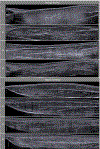Obtaining Quality Extended Field-of-View Ultrasound Images of Skeletal Muscle to Measure Muscle Fascicle Length
- PMID: 33369599
- PMCID: PMC8961472
- DOI: 10.3791/61765
Obtaining Quality Extended Field-of-View Ultrasound Images of Skeletal Muscle to Measure Muscle Fascicle Length
Abstract
Muscle fascicle length, which is commonly measured in vivo using traditional ultrasound, is an important parameter defining a muscle's force generating capacity. However, over 90% of all upper limb muscles and 85% of all lower limb muscles have optimal fascicle lengths longer than the field-of-view of common traditional ultrasound (T-US) probes. A newer, less frequently adopted method called extended field-of-view ultrasound (EFOV-US) can enable direct measurement of fascicles longer than the field-of-view of a single T-US image. This method, which automatically fits together a sequence of T-US images from a dynamic scan, has been demonstrated to be valid and reliable for obtaining muscle fascicle lengths in vivo. Despite the numerous skeletal muscles with long fascicles and the validity of the EFOV-US method for making measurements of such fascicles, few published studies have utilized this method. In this study, we demonstrate both how to implement the EFOV-US method to obtain high quality musculoskeletal images and how to quantify fascicle lengths from those images. We expect that this demonstration will encourage the use of the EFOV-US method to increase the pool of muscles, both in healthy and impaired populations, for which we have in vivo muscle fascicle length data.
Figures



Similar articles
-
Measuring fascicle lengths of extrinsic and intrinsic thumb muscles using extended field-of-view ultrasound.J Biomech. 2023 Mar;149:111512. doi: 10.1016/j.jbiomech.2023.111512. Epub 2023 Feb 18. J Biomech. 2023. PMID: 36842405 Free PMC article.
-
Demonstration of extended field-of-view ultrasound's potential to increase the pool of muscles for which in vivo fascicle length is measurable.J Biomech. 2017 Oct 3;63:179-185. doi: 10.1016/j.jbiomech.2017.08.012. Epub 2017 Aug 23. J Biomech. 2017. PMID: 28882331 Free PMC article.
-
In vivo measurements of biceps brachii and triceps brachii fascicle lengths using extended field-of-view ultrasound.J Biomech. 2016 Jun 14;49(9):1948-1952. doi: 10.1016/j.jbiomech.2016.03.040. Epub 2016 Apr 1. J Biomech. 2016. PMID: 27083062 Free PMC article.
-
Effects of physical training and detraining, immobilisation, growth and aging on human fascicle geometry.Sports Med. 2006;36(12):1003-17. doi: 10.2165/00007256-200636120-00002. Sports Med. 2006. PMID: 17123325 Review.
-
Ultrasound imaging to assess skeletal muscle architecture during movements: a systematic review of methods, reliability, and challenges.J Appl Physiol (1985). 2020 Apr 1;128(4):978-999. doi: 10.1152/japplphysiol.00835.2019. Epub 2020 Mar 12. J Appl Physiol (1985). 2020. PMID: 32163334
Cited by
-
Reliability of Panoramic Ultrasound in Assessing Rectus Femoris Size, Shape, and Brightness: An Inter-Examiner Study.Bioengineering (Basel). 2024 Jan 15;11(1):82. doi: 10.3390/bioengineering11010082. Bioengineering (Basel). 2024. PMID: 38247959 Free PMC article.
-
Fascicle Behavior and Muscle Activity of The Biceps Femoris Long Head during Running at Increasing Speeds.J Sports Sci Med. 2024 Sep 1;23(1):603-610. doi: 10.52082/jssm.2024.603. eCollection 2024 Sep. J Sports Sci Med. 2024. PMID: 39228786 Free PMC article.
-
Implementing Ultrasound Imaging for the Assessment of Muscle and Tendon Properties in Elite Sports: Practical Aspects, Methodological Considerations and Future Directions.Sports Med. 2021 Jun;51(6):1151-1170. doi: 10.1007/s40279-021-01436-7. Epub 2021 Mar 8. Sports Med. 2021. PMID: 33683628 Free PMC article. Review.
-
Measuring fascicle lengths of extrinsic and intrinsic thumb muscles using extended field-of-view ultrasound.J Biomech. 2023 Mar;149:111512. doi: 10.1016/j.jbiomech.2023.111512. Epub 2023 Feb 18. J Biomech. 2023. PMID: 36842405 Free PMC article.
-
The effects of hip- vs. knee-dominant hamstring exercise on biceps femoris morphology, strength, and sprint performance: a randomized intervention trial protocol.BMC Sports Sci Med Rehabil. 2023 Jun 26;15(1):72. doi: 10.1186/s13102-023-00680-w. BMC Sports Sci Med Rehabil. 2023. PMID: 37365624 Free PMC article.
References
-
- Gans C & Bock WJ The functional significance of muscle architecture: a theoretical analysis. Adv Anat Embryol Cell Biol. 38 115–142, (1965). - PubMed
-
- Gans C Fiber architecture and muscle function. Exercise and Sports Sciences Reviews. 10 160–207, (1982). - PubMed
-
- Lieber RL & Fridén J Functional and clinical significance of skeletal muscle architecture. Muscle & Nerve: Official Journal of the American Association of Electrodiagnostic Medicine. 23 (11), 1647–1666, (2000). - PubMed
-
- Zajac FE Muscle and tendon: properties, models, scaling, and application to biomechanics and motor control. Critical reviews in biomedical engineering. 17 (4), 359–411, (1989). - PubMed
Publication types
MeSH terms
Grants and funding
LinkOut - more resources
Full Text Sources
